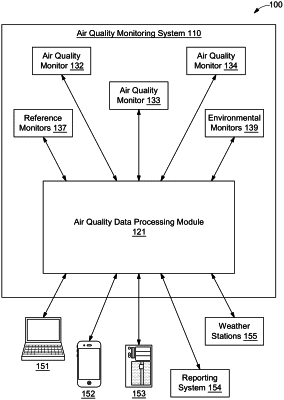| CPC G01N 33/0062 (2013.01) [G01D 21/02 (2013.01); G01N 33/0031 (2013.01); G01N 2033/0068 (2013.01)] | 24 Claims |

|
1. A total emissions quantification method for quantifying emissions of a target substance at a site, the total emissions quantification method comprising:
providing a first air quality monitor comprising:
a first sensor responsive to the target substance; and
a first location at which the first air quality monitor is located on the site;
measuring a first set of onsite parameters with the first air quality monitor over a period of time to obtain a plurality of individual measurements, the plurality of individual measurements comprising:
a first measured substance concentration of the target substance measured with the first air quality monitor; and
a first set of individual atmospheric readings;
transmitting the first set of onsite parameters to a first server;
procuring a regional atmospheric parameter for the site from a second server;
training a prediction model associated with the first air quality monitor, by:
generating a plurality of first predicted substance concentrations of the target substance corresponding to the first air quality monitor;
obtaining over a predefined period at a predefined frequency, the plurality of first predicted substance concentrations and the plurality of individual measurements of the first set of onsite parameters;
generating a mapping of a weighted mean of the plurality of first predicted substance concentrations grouped in each wind-direction bucket of a predetermined number of wind-direction buckets, wherein the predetermined number of wind-direction buckets together are representative of wind directions in a full circle; and
obtaining a location map of a plurality of emission sources at the site, the location map comprising:
a location and an identity associated with each of the plurality of emission sources;
generating a simulated plume model for each emission source of the plurality of emission sources with a wind-direction;
calculating a plurality of representative circular normal distributions for each air quality monitor, using the simulated plume model, by:
setting a plurality of presumed flux values to the simulated plume model;
analyzing the plurality of representative circular normal distributions in relation with the mapping of the weighted mean to identify:
a relevant representative circular normal distribution from the plurality of representative circular normal distributions,
wherein the relevant representative circular normal distribution is indicative of a target emission source from the plurality of emission sources; and
quantifying a total emission of the target substance at the site by aggregating the plurality of emission sources.
|